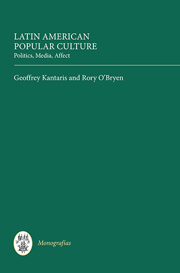Book contents
- Frontmatter
- Contents
- List of Illustrations
- Notes on Contributors
- Acknowledgements
- Introduction: The Fragile Contemporaneity of the Popular
- I Politics
- 1 ‘And where are the people?’ Genealogies of the pueblo during the Late Eighteenth and Early Nineteenth Centuries
- 2 Folktales and Fabulation in Lucrecia Martel's Films
- 3 How Popular is Cuban Popular Culture?
- 4 ‘El convertible no convertible’: Reconsidering Refuse and Disjecta Aesthetics in Contemporary Cuban Art
- II Media
- III Affect
- Index
2 - Folktales and Fabulation in Lucrecia Martel's Films
from I - Politics
Published online by Cambridge University Press: 05 October 2013
- Frontmatter
- Contents
- List of Illustrations
- Notes on Contributors
- Acknowledgements
- Introduction: The Fragile Contemporaneity of the Popular
- I Politics
- 1 ‘And where are the people?’ Genealogies of the pueblo during the Late Eighteenth and Early Nineteenth Centuries
- 2 Folktales and Fabulation in Lucrecia Martel's Films
- 3 How Popular is Cuban Popular Culture?
- 4 ‘El convertible no convertible’: Reconsidering Refuse and Disjecta Aesthetics in Contemporary Cuban Art
- II Media
- III Affect
- Index
Summary
Unannounced transitions, ellipses, openings in medias res, truncated dénouements: examples from Lucrecia Martel's films would fill a textbook on the subject of the disruption of narrative linearity. Their apparent rejection of the codes of storytelling creates an uncertainty and an ambiguity that confound conventional modes of critical interpretation. This has certainly been the experience of many of Martel's critics, who have found her films – in particular, La ciénaga (The Swamp, 2001) and La niña santa (The Holy Girl, 2004) – stubbornly resistant to attempts to tease out deeper meanings or to place them within their socio-political context (see, for example, Aguilar 2006: 24; Varas and Dash 2007: 198; Gundermann 2005: 241; Page 2009: 182–94). To add to the confusion, at different times Martel has variously sanctioned or rejected allegorical readings of her films. She has been more consistent in describing La mujer sin cabeza (The Headless Woman, 2008) as an allegory of society's complicity in Argentina's most recent military regime (Enriquez 2008); however, as I will argue below, this reading may occlude a more radical understanding of the film's politics.
Martel's films steer us unequivocally away from transcendental modes of criticism which would seek an ideological or political ‘meaning’ for the text, and towards the immanent approaches advocated and practised by Deleuze, which refer us always to relations rather than essences, construction rather than interpretation, and to the text as assemblage rather than a set of signifying codes to be cracked.
- Type
- Chapter
- Information
- Latin American Popular CulturePolitics, Media, Affect, pp. 71 - 88Publisher: Boydell & BrewerPrint publication year: 2013

